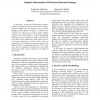Free Online Productivity Tools
i2Speak
i2Symbol
i2OCR
iTex2Img
iWeb2Print
iWeb2Shot
i2Type
iPdf2Split
iPdf2Merge
i2Bopomofo
i2Arabic
i2Style
i2Image
i2PDF
iLatex2Rtf
Sci2ools
ICPR
2006
IEEE
2006
IEEE
Adaptive Binarization of Historical Document Images
In this paper, we present a binarization technique specifically designed for historical document images. Existing methods for this problem focus on either finding a good global threshold or adapting the threshold for each area so that to remove smear, strains, uneven illumination etc. We propose a hybrid approach that first applies a global thresholding method and, then, identifies the image areas that are more likely to still contain noise. Each of these areas is re-processed separately to achieve better quality of binarization. We evaluate the proposed approach for different kinds of degradation problems. The results show that our method can handle hard cases while documents already in good condition are not affected drastically.
Computer Vision | Global Thresholding Method | Historical Document Images | ICPR 2006 | Uneven Illumination Etc |
| Added | 11 Jun 2010 |
| Updated | 11 Jun 2010 |
| Type | Conference |
| Year | 2006 |
| Where | ICPR |
| Authors | Ergina Kavallieratou, Efstathios Stamatatos |
Comments (0)

